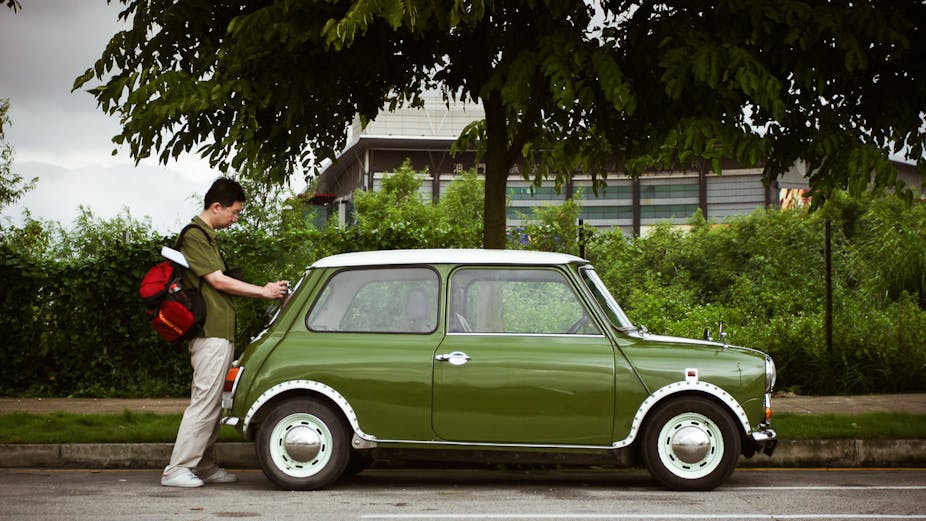Car enthusiasts say the Mini has endured because it is fun - fun to drive and fun to look at. However, as a design, the Mini endures because of how its designers worked within the constraints they were set and in how the design relates to the world around it.
Now as a brand that has a completely different focus, the original Mini is a design classic that has endured even though the world around it has changed.
The compact car
The 1959 Mini (or, properly the Morris Mini-Minor, or Austin 850, among several other variations) was a response to a very specific threat to the British motor industry in the 1950s.
A fuel crisis had prompted an interest in German “micro cars”, like the Messerschmidt and BMW Isetta, and the British Motor Corporation (BMC) didn’t have a competing product.
Car designer Alec Issigonis, who had previously designed the Morris Minor, was called back to BMC from Alvis Motors, and given the brief to design a small car “with a proper body and a proper engine”, to fit inside a footprint 10’ long by 4’ wide by 4’ high.

The design began with the timely and novel “east-west” drivetrain arrangement, involving an extremely compact four-cylinder engine and gearbox assembly, and left Issigonis and his team with the problem of fitting four people inside a space not much bigger than 8’ by 4’. This restriction was a response to the German micro-cars, most of which couldn’t seat four people and had two-cylinder engines.
The interior layout was achieved through what we’d today call low-fidelity prototyping, a method of using simple materials to help think about more complicated solutions. At the time of the Mini’s creation, designers called it “putting seats on the shop floor” and having people, from secretaries to factory workers, sit in them and indicate how much space they’d need inside a car.

This process helped the Mini’s design team to know how to arrange the parcel shelf under the dashboard and how to size the door bins. There are, of course, some quirks or personal touches to the Mini’s design. The door bins are infamously sized to accommodate a bottle of Gordon’s Gin and, while the first Mini had no provision for seat belts it was equipped with an ashtray - Issigonis was a chain smoker.
Even the iconic look of the Mini, simultaneously modernist and friendly, is a result of Issigonis’ response to the restrictions in the brief. A monocoque construction with the panel joins on the outside of the body, rather than hidden, mostly to gain precious quarter-inches inside, and a body shape that clearly says “the engine is here and people sit here” lend the Mini an honesty perhaps only matched by the Volkswagen Beetle and its sibling the Porsche 911.
Driving the tides of change
If the first Mini was a response to the world around it, later Minis were swept along with the tides of change. By 1967 Issigonis wanted to see his proposed replacement, the 9X prototype, enter production.

The 9X was smaller than the Mini, more efficient in its use of materials and easier to build. However, many competing interests, not the least the nationalisation of the British motor industry, got in the way and instead the Mini was updated but never really re-designed. It continued, mostly visibly unchanged until 2000, with a remarkable 41 year production run.
In the 1970s, the Mini remained in production even as BMC (by this stage known as British Leyland) took the same concept and modernized it, first with the the larger Allegro in the early 70s and then the mini-sized but far more modern-looking Metro in the 80s. Through this period the Mini remained competitive during the 80s against far more modern competitors by virtue of its small size and low cost.
The Mini revival
A revival of interest in the Mini in Japan in the early 80s led to continued interest in the UK and a second revival in the 90s led to niche sales across Europe. It was at this time that the Mini began to be appreciated as a classic in its own right, no small feat for an economy car, with the always strong enthusiast following achieving a critical mass.
Further, or perhaps continued, turmoil in the British Motor Industry led to the eventual sale of the Rover sub-brand and the rights to the Mini to BMW in the early 90s. When, in 2001, BMW launched the “new Mini”, or “MINI” as they used to insist, it mimicked the styling but not the human-centred design of the original Mini. The new MINI is a response to changing pressures in the automotive market.

The new MINI, now in its third re-design, is positioned as a premium car, rather than a car for everyone, and competes not on efficiency but on image. The MINI is undoubtedly successful but the entire industry has changed and the specific challenges the Mini addressed in 1959 are no longer relevant.
The Mini endures as a design classic because of how it responds to the world around it and the specific vehicle demands, whether economic or aesthetic, of the time.
Read more articles in the Sublime Design series.
Are you an academic or researcher? Is there a design classic – industrial, graphic, urban, architectural, interior or landscape – you would like to write about? Contact the Arts + Culture editor.

